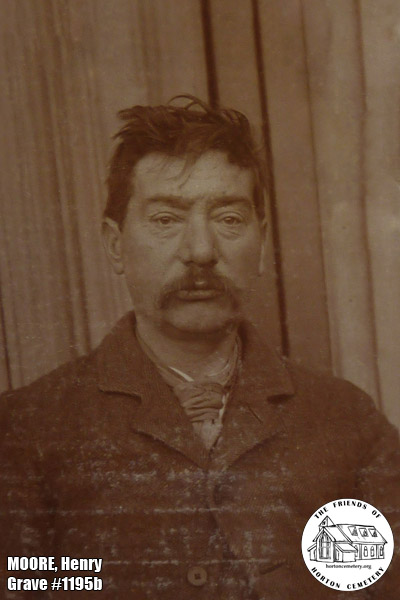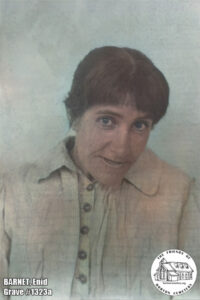b.1859-d.1912
Henry’s parents
Henry Rose Moore was born in the June quarter of 1859 in Clerkenwell, Middlesex. He takes his unusual second name from his grandfather, Thomas Rose Moore. Henry was the oldest child of Edwin (1837-1886) and Maria Anne Moore née Wright (1839-1898). Edwin and Maria married on 2nd August 1857 at St John’s Church, Hoxton, Middlesex and together they had nine children.
Edwin’s occupation is given as Coach Trimmer and this was a trade that several of his children followed. In the early days this probably meant working on horse drawn carriages but later as the railways grew in London it may have meant railway coaches and later still motor buses. It appears to have been good steady work for this family.
Henry’s siblings
In the first census after Henry’s birth, in 1861, the family were living at 14, Vineyard Walk, Clerkenwell which is just off Farringdon Road and is shown in Booth’s poverty maps of the late 1800’s as ‘poor/mixed’. Henry is 2 years old and already Edwin and Maria have another son, Arthur, born 1861.
Before the next census they were joined by Walter, born 1864, but then there appears to have been a long gap until 1872 when Thomas arrived followed by Rosina in 1874 and Catherine in 1876. These last three children were born in Hastings, Sussex but unfortunately there is no 1871 Census entry for the family.
1881-1901
By 1881 they have moved back and are living at 51, Coopers Road, Camberwell, just off the Old Kent Road and have two more children, Edwin, born 1877, and Albert, born 1880. Their final child, William, was born in 1882. None of Edwin and Maria’s children appears to have been baptised. 51, Coopers Road seems to remain as the family home until at least 1901. It is shown in Booth’s Maps as “fairly comfortable – good income”.
The 1881 Census shows that Henry, Arthur and Walter are all working with their father as Coach Trimmers but then in Feb 1886 their father, Edwin, dies aged just 49. He is buried in Camberwell Old Cemetery. Maria and the family continue to live in Coopers Road but in the 1891 Census Henry is found in Aldershot, shown as a “night lodger”.
What might have caused this move or how long he stayed away we can’t know but following his mother’s death in January 1898 he returns and is shown as ‘Head’ of the family in the 1901 Census when all the siblings are living together in Coopers Road.
Two deaths in the family
This is when things begin to change. In 1902 Rosina marries Harry James Purkiss, they have one child, Harry Albert Edwin, in 1903 and then sadly Rosina dies in 1908 aged 35.
I believe that Henry’s brother Edwin died in 1909 aged 32, and is buried in the same cemetery as his parents.
In 1911 we find Henry as a patient in the ‘Epsom Colony’, he was admitted on 6th March 1909. Chargeable to Camberwell Union.
On admission Henry is 50 years old, single and his occupation is given as coach trimmer. Later it is noted that he was previously able to earn his living but has been out of work these past 8 months. Henry’s sister Catherine Moore is given as the person to contact, she is living at 18, Trafalgar Rd, Peckham. However, in the visitors’ book it is noted that a letter sent to this address in 1910 was returned as “house unoccupied.”
Facts indicating insanity observed by J.F.A. Adolphus.
“Strange in his manner and behaviour. Dull and lost, has little memory, says he has Epileptic fits and does not know where he is. Has delusions as to what he is here for and says, he got up in the night to go to work and couldn’t find his greatcoat.”
His principle illness is Epilepsy. Contributory factors Alcohol, Cardio Vascular degeneration and Syphilis.
Henry’s brother Thomas gave a scant account of his history. He confirms that he is the eldest of eight children (his sister Rosina having just died.) He says he was a “moderate drinker” but he knew nothing about his early life or other illnesses.
His father and mother are both dead as is one sister who died of consumption.
Physically Henry’s general health is “impaired.” He is 5’8” and heavily built at 11st 4lb’s, with Grey eyes and dark hair. He has poor teeth and an awkward, shuffling gait but his speech is clear.
Henry’s heart is “Large, arrhythmic and dull” and Syphilis is “certain” as the patient admits he “had the pox” 9yrs ago.
Mentally he is said to have a poor understanding of current events but gives a “fair account of his name and age although he is vague on what he does.”
He suffers no hallucinations or delusions but his prevailing feelings are depression and dullness. He is not suicidal nor excitable, restless or noisy.
Henry admits to “some Saturday night excess.”
On 13th March we find the Admission report to C in L (we are unsure what this stands for.)
He is suffering Insanity with Epilepsy. He is dull, vacant and confused…..
Hazy as to the duration of his Epilepsy which is probably recent and is associated with chronic alcoholism and specific venereal disease…….”
*note a sudden inflation in his ‘alcoholism’.
In early April Henry begins work, we think on the farm, and “appears hardly so dull as formally,” however by May he is still working but is “inefficient as a Colonist”
As time goes on he is said to be “very well behaved and more energetic, not so depressed.” Throughout the year his seizures are very few and he is not on any medication.
In January 1910 we find Henry in Pine (hospital) ward being treated for a leg ulcer. The report of the S.R to C in L says that he is “labouring under Insanity with Epilepsy evidenced by well marked dementia.” Throughout this year Henry appears to be constantly in hospital with leg problems, often confined to bed, and then in January 1911 on examination, he is found to have heart problems.
In the Report of the Senior Registrar in February we are told that Henry has “Epileptic insanity” (this is a man who has until now been experiencing possibly six seizures per quarter.) He is feeble minded, restless and given to “picking himself.” He has occasional Epileptic fits. Impaired health with aortic disease and a considerable degree of albuminuria. (a typical symptom of kidney disease.) Confined to bed with ulceration of both legs aggravated by ‘picking.”
In April we hear that Henry is up, and his legs are better but we see a marked increase in his seizures. Below is the 1911c showing Henry in “The Colony.”
Just before Christmas 1911 Henry was found to have bruising across his ribs, and on his arms and thighs on his left side, “cause unknown.” Could this have been a severe seizure, a prelude to what followed?
Henry’s death
One the morning of 3rd January 1912 Henry has two convulsive seizures which affected his right side only, afterwards he is found to be Aphasic (the inability to understand or produce speech due to brain damage.) and showed considerable Paresis (paralysis) of the right side.
As the month went on Henry’s condition remained very feeble and he was unable to speak clearly and then on the 9th January, “Colonist appears to be worse, has not passed urine for 24hrs” this was treated unsuccessfully.
The following day, 10th January 1912 it was noted “Colonist gradually got worse yesterday and in the evening was “pulseless and obviously moribund” (at the point of death) Died last night at 8.50pm.”
Henry was buried in the Horton Estate Cemetery on 15th January 1912 in grave 1195 b.
The Epsom Colony
The Epsom Colony was part of the ‘Epsom cluster,’ a group of mental hospitals built in the Surrey countryside in the latter part of the 1800’s to take the overflow from the Metropolis. ‘The Colony’ specialised in the care of the “Epileptic Insane”.
The Colony opened in 1902 and was of a modern design made up of small bungalows grouped together to form a community. Most people who were able worked on the farm, or in the dairy, bake house or laundry all of which supported those living in the hospital cluster.
Henry’s siblings after his death
Rosina married in 1902 but had recently died when Henry was admitted to the Colony in 1909 leaving one son.
Catherine, Albert and William are shown in the 1911c living together in Bermondsey, and then in 1915, at the age of 39yrs Catherine married Frederick Arthur Strange. In the 1939 register brother Albert is still living with his sister and her husband in Bermondsey. Catherine died in 1965.
I believe Walter lived on unmarried and appears in the 1939 register as a ‘Motor Trimmer’ retired.
Edwin did not marry and possibly died January 1909.
William may have died of wounds in France 1915, or possibly married a lady called
Susanna and appears on the 1939 register living in the Sutton and Cheam area.
Authors note*
You will note that there is a long gap in the family when no children were born 1864 – 1872. I have read that this can sometimes be attributed to Syphilis which can affect conception for a period of time and then clears to allow further children to be born.
Henry came into the asylum straight from home and lived just 2yrs and 3months. He already had some pretty serious health problems, had these been picked up before admission? Were they already too far advanced to be able to help him?
It was good to see that he was not forgotten, and we see from the visitor’s book that roughly twice a year he was visited by one or other of his brother’s, Arthur, Thomas and Walter or by one of his Jones family cousins.
Visits stopped in summer 1910; perhaps by then Henry was no longer receptive to visitors?




